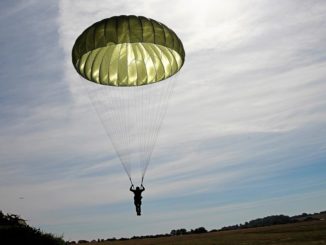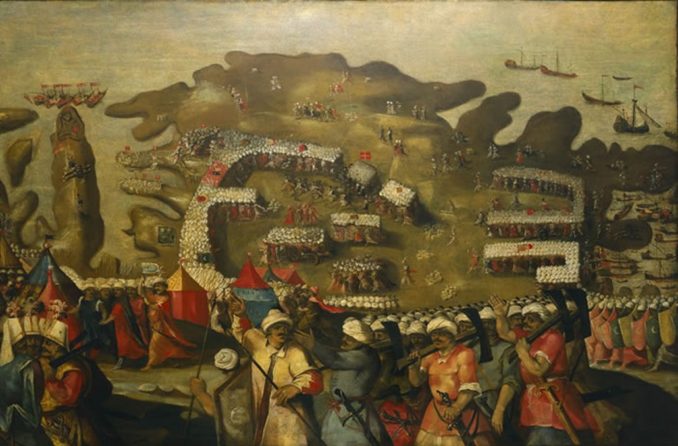
Matteo Perez d’Aleccio [Public domain], via Wikimedia Commons
Background
Islam would be spread into Europe by conquest, forced conversion to the faith by fire and sword. The Crusades were over, initially successful attempts by European Christians to seize back the Holy Land, known then as Outremere, the Kingdom of Jerusalem. Outremere was not a Muslim land, it had been conquered from what is now Arabia and the Christian kings and popes wanted it back. Terrible slaughter was done by all of the protagonists, but a succession of weak kings and indifference led to the fall of Constantinople.
In truth Europe had its own internal problems. Four years after the Knights took possession of Malta, one of the Order’s most influential and of course, wealthy “Langues” fell afoul of Henry VIII, who as part of his break from Rome had the Order abolished and its goods seized. His work was now being carried on by his daughter Elizabeth, and the country was gripped by a schism between the two arms of the same faith and the ever present threat from Spain. Following the Revolt of the Netherlands in 1568, Philip waged a campaign against Dutch heresy and secession. It also dragged in the English and the French at times and expanded into the German Rhineland with the Cologne War. This series of conflicts lasted for the rest of his life. Philip’s constant involvement in European wars took a significant toll on the treasury and caused economic difficulties for the Crown and even bankruptcies.
The first probable order of the Knights Hospitallar were the Knights of the order of St John. Like the Knights Templar they were monks who had taken an oath of responsibility to care for pilgrims to the Holy Land and the sick. These knights would have to accompany the caravans carrying pilgrims for protection. Knights from other orders who contracted leprosy had to join the St Lazarus order of the Knights Hospitallar. Eventually these would split into two separate branches.
Once the last Christians had been expelled from the Holy Land and Cyprus by the Muslims, the last vestige of Christianity in the area were the Knights of St John who had settled in Rhodes, a verdant island on which they built magnificent fortifications. Because they were now based on an island dependent on the sea, the knights became skilled seafarers and protected Christian ships sailing in the area. This was a logical progression as tactics dictated that ships should close, engage and board the enemy to settle the issue up close and personal. The knights successfully raided and captured Muslim ships and grew rich and powerful on the bounties. Eventually the 26 year-old Turkish Suliman the Magnificent had enough and laid siege to Rhodes. The siege was a protracted and bloody affair and eventually he received the surrender from the Grand Master of the Order. Believing he had seen the last of the Order of St John, the Emperor was magnanimous in victory and allowed the knights to sail away on their galleys. It was a decision he would come to regret.
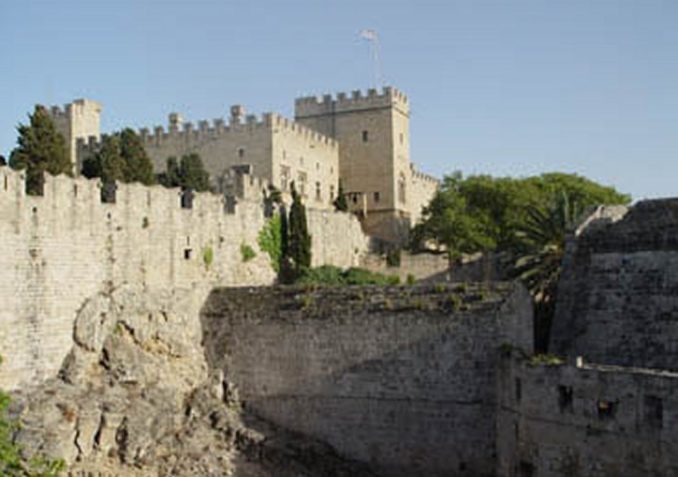
Antiquarian at English Wikipedia [CC BY-SA 3.0], via Wikimedia Commons
The harbour was the strategic centre of gravity of the island and the Order turned Malta into a naval base, its position in the centre of the Mediterranean made it a strategic gateway between East and West. It was an important base against the Barbary Corsairs who had turned the enslavement of the Christian inhabitants of the coastline communities into a barbaric art form, long before the Atlantic slave trade. Ohio State University history Professor Robert Davis describes the White Slave Trade as minimised by most modern historians in his book Christian Slaves, Muslim Masters: White Slavery in the Mediterranean, the Barbary Coast and Italy, 1500–1800 (Palgrave Macmillan). Davis estimates that 1 million to 1.25 million white Christian Europeans were enslaved in North Africa, from the beginning of the 16th century to the middle of the 18th, by slave traders from Tunis, Algiers, and Tripoli alone (these numbers do not include the European people which were enslaved by Morocco and by other raiders and traders of the Mediterranean Sea coast), 16th- and 17th-century customs statistics suggest that Istanbul’s additional slave import from the Black Sea may have totalled around 2.5 million from 1450 to 1700. The markets declined after the loss of the Barbary Wars and finally ended in the 1830s, when the region was conquered by France. The figures also don’t include Africans enslaved by Muslims all the way along the continent’s eastern coastline and sold in the slave markets of Zanzibar.
In particular, the corsair Dragut was proving to be a major threat to the Christian nations of the central Mediterranean. Dragut and the Knights were continually at loggerheads. In 1551, Dragut and the Ottoman admiral Sinan decided to take Malta and invaded the island with a force of about 10,000 men. After only a few days, however, Dragut broke off the siege and moved to the neighbouring island of Gozo, where he bombarded the Cittadella for several days. The Knights’ governor on Gozo, Gelatian de Sessa, having decided that resistance was futile, threw open the doors to the Cittadella. The corsairs sacked the town and took virtually the entire population of Gozo (approximately 5,000 people) into captivity. Dragut and Sinan then sailed south to Tripoli, where they soon seized the Knights’ garrison there. They initially installed a local leader, Aga Morat, as governor, but subsequently Dragut himself took control of the area.
The Grand Master of the knights expected another Ottoman invasion and ordered the strengthening of Fort Saint Angelo at the tip of Birgu (now Vittoriosa), as well as the construction of two new forts, Fort Saint Michael on the Senglea promontory and Fort Saint Elmo at the seaward end of Mount Sciberras (now Valletta). The two new forts were built in the remarkably short period of six months in 1552. All three forts proved crucial during the Great Siege. The Forts of St Michael and St Angelo could provide mutually supporting fire and a chain and pontoon bridge stretched between them, however, Fort St Elmo was isolated near the entrance to the Grand Harbour. The knights’ ships from Malta continually harried Ottoman trading ships in the Mediterranean, which outraged Suliman and he bitterly regretted his clemency to the knights on Rhodes.
Maps showing main defences of Malta
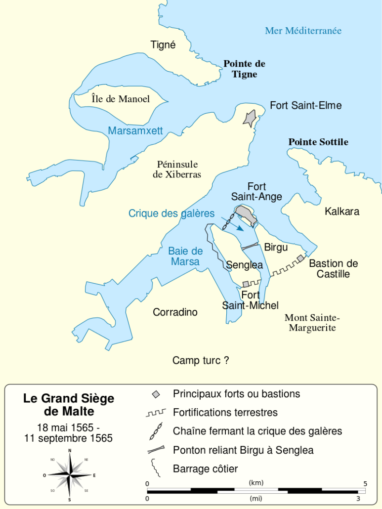
© Sémhur / Wikimedia Commons, via Wikimedia Commons

Xwejnusgozo [CC BY-SA 4.0], via Wikimedia Commons
Plans and Preparations
Fort St Elmo as had the others were built quickly and the material used was sandstone and limestone. Because it was built on solid rock it would be difficult to undermine, but there was a lack of interior defences due to time constraints. St Elmo’s outer defences were bolstered by an outer earthworks and deep ditches and a revelin (a detached fort facing the inland approach to the walls). It was built of earth and fascines, which all had to be imported from Sicily because the island was so barren.
One incident that made Suliman incandescent with rage was the capture by one of the Order’s most able commander, Chevalier Romegas, of a ship bringing luxury goods from Venice to Turkey. The plunder was worth 80,000 Ducats and the haul also included several distinguished subjects who were held to ransom. The crew of the captured ship were put to work as slave oarsmen, while the Christian slave oarsmen were released to serve with the knights. This lucrative enterprise had been set up by Suliman’s favourite daughter of his favourite concubine, Mihrmah who along with the Imams, screamed for revenge as: believers of the one true faith were been flogged like dogs on the oars of Christian ships. In October 1654 Suliman called a Divan or grand council.
However, Suliman’s desire to capture Malta was a strategic as well as a vengeful decision. By ridding Malta and the world of the knights, the pathway to Sicily, Italy and Spain would be open and then all of Europe. The Ottoman fleet would me masters of a Muslim sea, his defeat at Vienna would be rendered irrelevant and all of Europe would lie beneath the banner of the crescent moon. Those sons of dogs, whom I have already conquered and who were spared only by my clemency at Rhodes forty-two years ago, I say now that for their continual raids and insults they shall finally be crushed and destroyed.
The Opposing Leaders and Forces
Suliman did not lead the campaign, but his figure loomed large over the Muslim army and he masterminded the campaign. Under Suliman’s rule the Ottomans had gained the territories of Aden, Algiers, Baghdad, Belgrade, Budapest, Nakhichevan, Rivan, Tabriz, Temesvar, and Rhodes. He was an extremely able leader, both politically and militarily and he was now seventy. Mustapha Pasha was Suliman’s commander designate, a veteran of the Persian Wars and Hungarian campaign, an able solder renowned for his hatred of Christians and barbaric cruelty. He wanted to see the Order wiped out and thirsted for the blood of the knights.
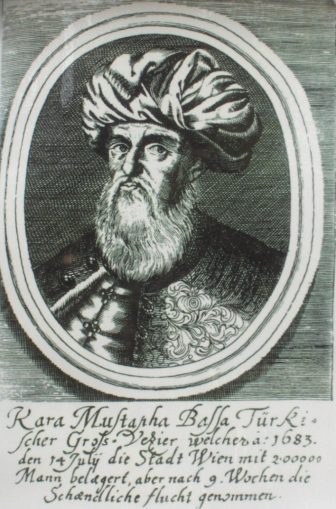
G. Jansoone [Public domain], via Wikimedia Commons
The Grand Master of the Order of the Knights Hospitallar was Jean Parisot de la Valette. He was born in 1494 in Provence, his family descended from the hereditary counts of Toulouse and his ancestors had taken part in the Crusades. At the age of twenty he had joined the Order of St John and was totally dedicated to its cause. Once he joined he never saw his family or homeland again. He had been present during the Order’s greatest disaster, the fall of Rhodes, its homeland after the seizure of the Holy Land by the Muslims. He was instrumental in changing the Order from knights on horseback to a naval force and from Rhodes the knights sallied out in their galleys to loot and plunder Ottoman shipping, becoming a thorn in their side.
In 1541 Jean Parisot de la Valette led his galley the San Giovani into action, against the pirate Abd-ur-Rahman Kust Ali. It was the only time in his life he was defeated and badly wounded, de la Valette was chained naked to an oar and spent the next year as a galley slave. Remarkably he survived the ordeal while many around him died and he gained his freedom in a prisoner exchange one year later. He became chief admiral of the Order’s galleys and while his rise was not meteoric, he was voted the Grand Master in 1557. He ordered the strengthening of Malta’s defences and completed the outer defences of Fort St Elmo. He also established an efficient network of spies and thus knew of the Turkish plans to invade the islands. The entire blame for defeat, or triumph of victory would belong to Jean Parisot de la Valette.
Pickles, T., 1998. Malta 1565: Last Battle Of The Crusades (campaign). Osprey Publishing.
https://en.wikipedia.org/wiki/Great_Siege_of_Malta
https://en.wikipedia.org/wiki/Barbary_slave_trade
© Blown Periphery 2019
The Goodnight Vienna Audio file
Audio Player



